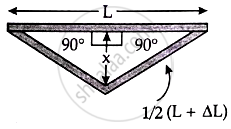Advertisements
Advertisements
प्रश्न
A rail track made of steel having length 10 m is clamped on a raillway line at its two ends (figure). On a summer day due to rise in temperature by 20° C, it is deformed as shown in figure. Find x (displacement of the centre) if αsteel = 1.2 × 10–5/°C.

उत्तर
Consider the diagram

Applying Pythagoras theorem in the right-angled triangle in figure
`((L + ΔL)/2)^2 = (L/2)^2 + x^2`
⇒ `x = sqrt(((L + ΔL)/2)^2 = (L/2)^2)`
= `1/2 sqrt((L + ΔL)^2 - L^2)`
= `1/2 sqrt((L^2 + ΔL^2 + 2LΔL) - L^2)`
= `1/2 sqrt((ΔL^2 + 2LΔL)`
As increase in length ΔL is very small, therefore, neglecting (ΔL)2, we get
`x = 1/2 xx sqrt(2LΔL)` ......(i)
But ΔL = LαΔt ......(ii)
Substituting the value of ΔL in equation (i) from equation (ii)
`x = 1/2 sqrt(2L xx LαΔt)`
= `1/2 L sqrt(2αΔt)`
= `10/2 xx sqrt(2 xx 1.2 xx 10^-5 xx 20)`
= `5 xx sqrt(4 xx 1.2 xx 10^-4)`
= `5 xx 2 xx 1.1 xx 10^-2`
= 0.11
= 11 cm
APPEARS IN
संबंधित प्रश्न
A hole is drilled in a copper sheet. The diameter of the hole is 4.24 cm at 27.0 °C. What is the change in the diameter of the hole when the sheet is heated to 227 °C? Coefficient of linear expansion of copper = 1.70 × 10–5 K–1.
A 10 kW drilling machine is used to drill a bore in a small aluminium block of mass 8.0 kg. How much is the rise in temperature of the block in 2.5 minutes, assuming 50% of power is used up in heating the machine itself or lost to the surroundings Specific heat of aluminium = 0.91 J g–1 K–1
If mercury and glass had equal coefficients of volume expansion, could we make a mercury thermometer in a glass tube?
Is it possible for two bodies to be in thermal equilibrium if they are not in contact?
The density of water at 0°C is 0.998 g cm–3 and at 4°C is 1.000 g cm–1. Calculate the average coefficient of volume expansion of water in the temperature range of 0 to 4°C.
Answer the following question.
Give an example of the disadvantages of thermal stress in practical use?
A glass flask has a volume 1 × 10−4 m3. It is filled with a liquid at 30°C. If the temperature of the system is raised to 100°C, how much of the liquid will overflow? (Coefficient of volume expansion of glass is 1.2 × 10−5 (°C)−1 while that of the liquid is 75 × 10−5 (°C)−1).
Solve the following problem.
In olden days, while laying the rails for trains, small gaps used to be left between the rail sections to allow for thermal expansion. Suppose the rails are laid at room temperature 27 °C. If maximum temperature in the region is 45 °C and the length of each rail section is 10 m, what should be the gap left given that α = 1.2 × 10–5K–1 for the material of the rail section?
A clock pendulum having coefficient of linear expansion. α = 9 × 10-7/°C-1 has a period of 0.5 s at 20°C. If the clock is used in a climate, where the temperature is 30°C, how much time does the clock lose in each oscillation? (g = constant)
An iron plate has a circular hole of a diameter 11 cm. Find the diameter of the hole when the plate is uniformly heated from 10° C to 90° C.`[alpha = 12 xx 10^-6//°"C"]`
